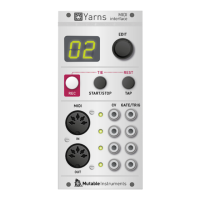
Do you have a question about the Mutable Instruments Yarns and is the answer not in the manual?
| Category | Media Converter |
|---|---|
| Width | 10HP |
| Depth | 25mm |
| CV Output Range | 0V to +8V |
| MIDI to CV/Gate | Yes |
| Polyphony | 4 voices |
| Clock Output | Yes |
| Clock Division | Yes |
| Arpeggiator | Yes |
| Sequencer | Yes |
| USB MIDI | Yes |
| DIN MIDI | Yes |
| Outputs | 4x CV, 4x Gate |
| Gate Output Voltage | +5V |
Explains the function of the encoder and three buttons for controlling the sequencer and recording.
Details the functions of REC, START/STOP, and TAP buttons for sequencer recording and playback.
Lists and describes various layouts like Monophonic (1M), Duophonic (2P), Quadraphonic (4P), and Trigger modes (4T).
Details CV/Gate assignments for single-voice (1M, 2>) and dual-voice (2M, 2P, 4>) layouts.
Explains CV/Gate assignments for quad-voice (4M, 4P, 8>) and quad-trigger (4T) layouts, including routing details.
Describes settings for selecting module layout and active parts for multi-timbral configurations.
Explains MIDI reception channel and note settings, including omni mode and 4T specific note triggers.
Configures MIDI output routing for events, THRU, or arpeggiator/sequencer data.
Details voice allocation methods (POLY, CYCLIC, RANDOM, VELOCITY) and note priority (LOWEST, HIGHEST, LATEST).
Steps for recording sequences using the REC button, MIDI keyboard, TIE/REST buttons, and re-recording.
Steps for calibrating CV outputs using a multimeter to adjust voltages to target values.
How to power on Yarns with the encoder pressed to wait for SysEx data transfer.
Details on sending SysEx data, packet handling, error indication (Er), and recommended tools.
